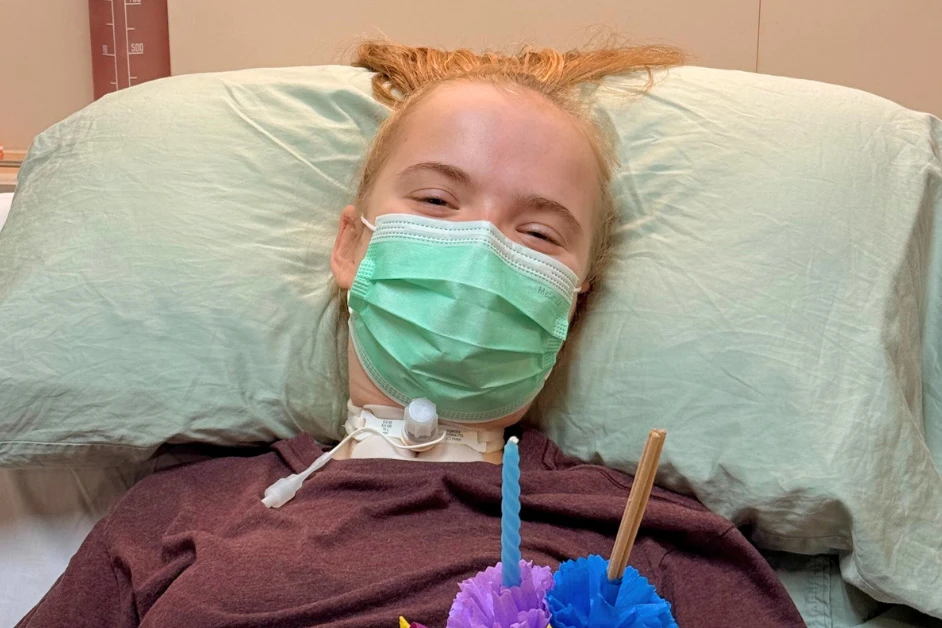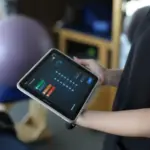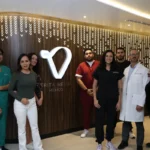In a recent YouTube Live and Facebook Live Q&A session, Global Medical Director Dr Nasir and Patient Representative Vea were joined by Makayla, a quadriplegic C3 complete spinal cord injury patient from the USA, and her mother Taran. They shared their experience of the Epidural Stimulation and Stem Cell treatment Makayla received at our hospital in Bangkok, Thailand.
Makayla’s Story So Far: “That first voluntary contraction in my arms was something I’ll never forget.”
Please introduce yourself and tell us about your injury.
Makayla: My name is Makayla Conde. I’m 16 years old from the United States. Almost three years ago, I was in an accident that left me a C3 complete quadriplegic. I was at a kickoff to a summer pool party with my church youth group, and I was on a tyre swing with my sister and two friends when the branch broke and it landed on my head. It broke my C4, C5, and C6 vertebrae, it cracked my skull, broke my clavicle, and broke my elbow. I was in the hospital for about seven months.
How did you find out about Verita Neuro, and what was the decision-making process like?
Makayla: We were trying to find a way for me to get rehabilitation. We contacted a lot of facilities here in the United States, but because of my age and because of my condition, none of them would take me. So, my mom started looking into other options and found Verita Neuro.
Taran: With the limitations that we found in physical and occupational therapy in the U.S., we were at a point where we were desperate to find something else. I found Verita Neuro through internet research, watched a lot of Q&As and decided to reach out. I was able to speak directly with Dr Nasir and the team at Verita Neuro, who were instrumental in our decision-making process. From the initial consultations to our ongoing communications, they were incredibly informative and supportive. They not only addressed all our concerns but also connected us with other families who had similar experiences. This level of personal interaction and genuine care played a crucial role in making our journey less daunting and more hopeful. It evolved into an incredible experience and a great journey for us.
What were your expectations before starting the treatment?
Makayla: I tried to manage my expectations. Based on what I had been told about spinal cord injuries, I knew that recovery wasn’t guaranteed and progress could be very slow. When we found out about epidural stimulation, I didn’t want to set unrealistic goals. My main expectation was to give it my all and see what could happen. I approached treatment with an open mind, knowing every case is unique, and I just wanted to do my best. I wasn’t expecting miracles, but I hoped for any sign of improvement.
What treatment did you receive from Verita Neuro?
Makayla: I received two Epidural Stimulators, Stem Cell treatment, and physical therapy.
Dr Nasir: Like many other patients in the past, Makayla also had a traumatic spinal cord injury to the cervical spinal cord, which resulted in loss of upper body and lower body functions. She received two stimulators; one was for the cervical plexus – there is a network of nerves in the spinal cord which branch out from the lower cervical spinal cord and supply the muscles in the upper body. This was our first target, using one stimulator at the cervical level to try to optimize the functions in her upper body. Then, at the same time, she received a second stimulator for the lumbar spinal cord, which is primarily responsible for leg function.
The epidural stimulation is a neurostimulator, and it is used to provide controllable, precise electrical stimulations to different structures in the spinal cord. When we use epidural stimulation, we are trying to cause the excitation of the spinal cord below the level of the injury, which is no longer being excited from brain signals. Once the spinal cord is excited, the muscles are able to be stimulated, and then slowly over time, patients regain control over those muscles, and it becomes volitional, controllable movement.
Can you describe the facilities at Verita Neuro in Bangkok where you received your treatment?
Taran: The facilities at Verita Neuro in Bangkok were outstanding. Not only was the medical equipment state-of-the-art, but the entire environment was set up to ensure comfort and promote healing. The clean, modern, and patient-orientated setup helped ease our anxiety, making Makayla’s intensive treatment schedule more manageable. The accessible layout and attentive care staff ensured that all her needs were met promptly, which was crucial for her recovery.
How did you feel before and after the surgery?
Makayla: Before the surgery, I was a mixture of nerves and excitement. It felt surreal to think that I might actually experience some kind of movement again. After the surgery, the changes were almost immediate, which was shocking. Just two days later, I was already starting to see movements during the mapping process. It was overwhelming in the best way possible. It felt like a part of me that had been dormant for so long was waking up. That first voluntary contraction in my arms was something I’ll never forget.
What improvements have you seen since the Epidural Stimulation surgery and Stem Cell treatment?
Makayla: The improvements started almost immediately. Two days after surgery, I began seeing movement in my arms during the mapping sessions. By the end of my treatment, I had gained voluntary control of my triceps, which I didn’t have before. My trunk control also improved, and I’m now able to stand with assistance. The Stem Cell treatment has enhanced my sensation, especially internally—I can feel my muscles contract when the stimulator is on. My bladder control has improved, and my temperature regulation has normalized, especially at night. I used to struggle with nerve pain, but that has significantly reduced, and I no longer need to take Gabapentin for it.
Can you talk us through what a typical day of treatment looks like at Verita Neuro?
Makayla: A typical day at Verita Neuro was intense but rewarding. We’d start at 9 am with two hours of upper body mapping, focusing on my arms, shoulders, and hands, working to identify which electrodes stimulated specific muscles. After a three-hour break for lunch, I’d have an hour of regular physical therapy where we’d work on balance, stretching, and sometimes standing exercises. Then, the final two-hour session would focus on lower body mapping, including trunk control, leg movements, and standing. Some days, I’d also have pelvic floor therapy. On average, I’d spend about 5-6 hours a day in therapy, six days a week, but some days stretched up to seven hours.
What were the biggest challenges during your treatment?
Makayla: The biggest challenges were the physical and emotional toll that intensive daily therapy took on me. It was exhausting, and there were days I felt overwhelmed by the sheer effort required. However, the support from the medical team and my family kept me going through the tough days.
How has this treatment impacted your daily life?
Makayla: Since the treatment, I’ve noticed significant improvements in my daily life. I have more independence and can do things I couldn’t before, like better control of my upper body, which helps with simple tasks like using a computer or eating. The psychological boost from seeing these improvements has been immense.
What support did you receive from Verita Neuro’s staff during your stay?
Makayla: The staff at Verita Neuro were incredible. They were not only professional and highly skilled but also genuinely caring and supportive. They made sure I understood each step of the process and were always there to encourage me during my therapy sessions.
Looking Forward: Makayla’s Goals for the Future
What advice would you give to others considering this type of treatment?
Makayla: My advice to others considering this treatment would be to go into it with an open mind and realistic expectations. It’s important to commit fully and be prepared for hard work. The journey is tough but worth it if you’re ready to put in the effort.
How do you view the future now, after undergoing Epidural Stimulation and Stem Cell treatment?
Makayla: My outlook on the future has changed dramatically. I feel more hopeful and excited about the possibilities. While I know there are still many challenges ahead, I believe that the improvements I’ve seen have opened up new opportunities for further recovery.
Can you describe the emotional journey you’ve been through since starting this treatment?
Makayla: This treatment has been an emotional rollercoaster. Initially, I was anxious and unsure, but seeing physical improvements brought a lot of joy and hope. It’s been uplifting but also mentally taxing, and I’ve learned a lot about resilience and the power of a positive mindset.
The above is not a verbatim transcript of Makayla’s live interview. Some comments have been altered or rearranged to improve the reading flow. You can watch the full live show on our YouTube channel.





